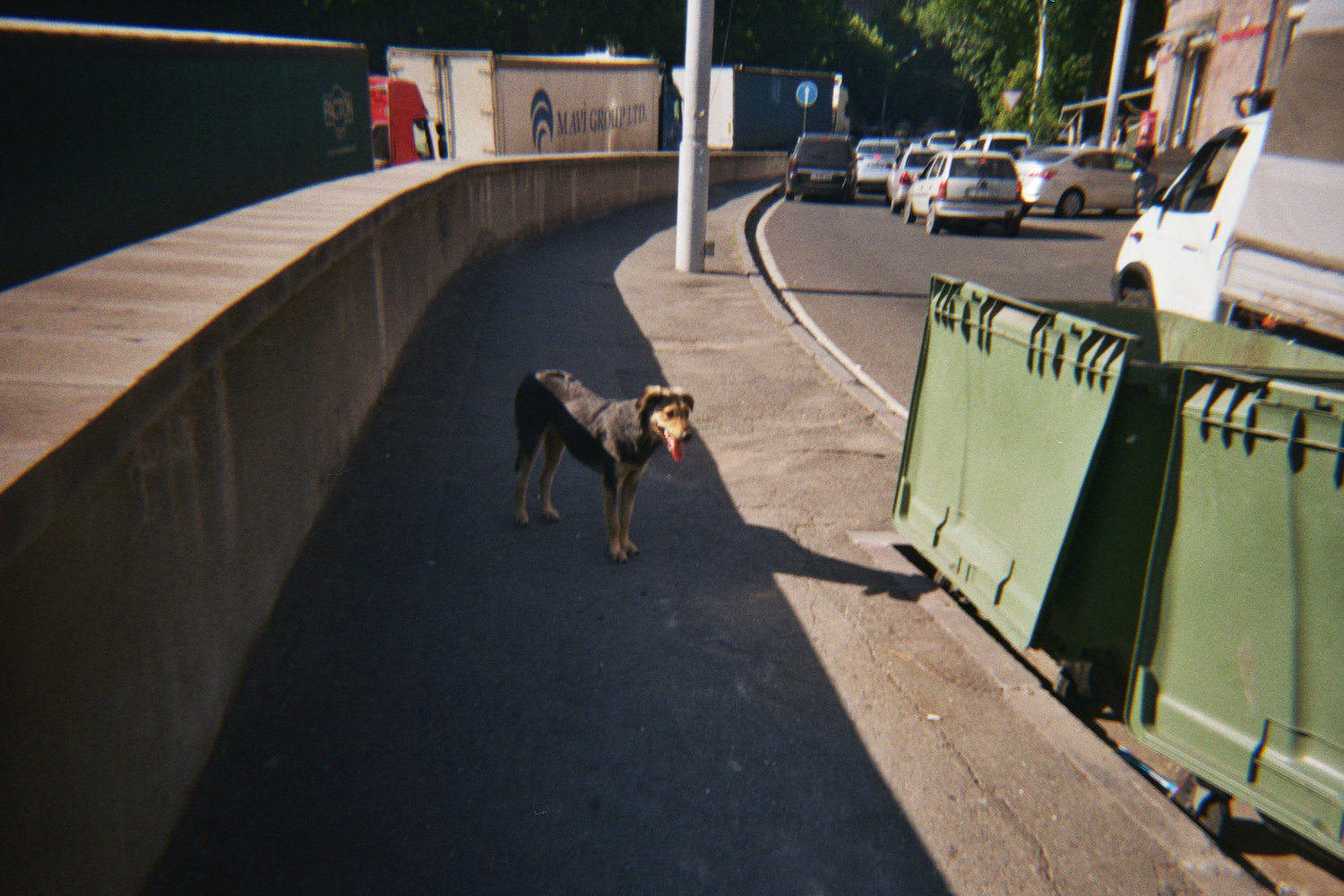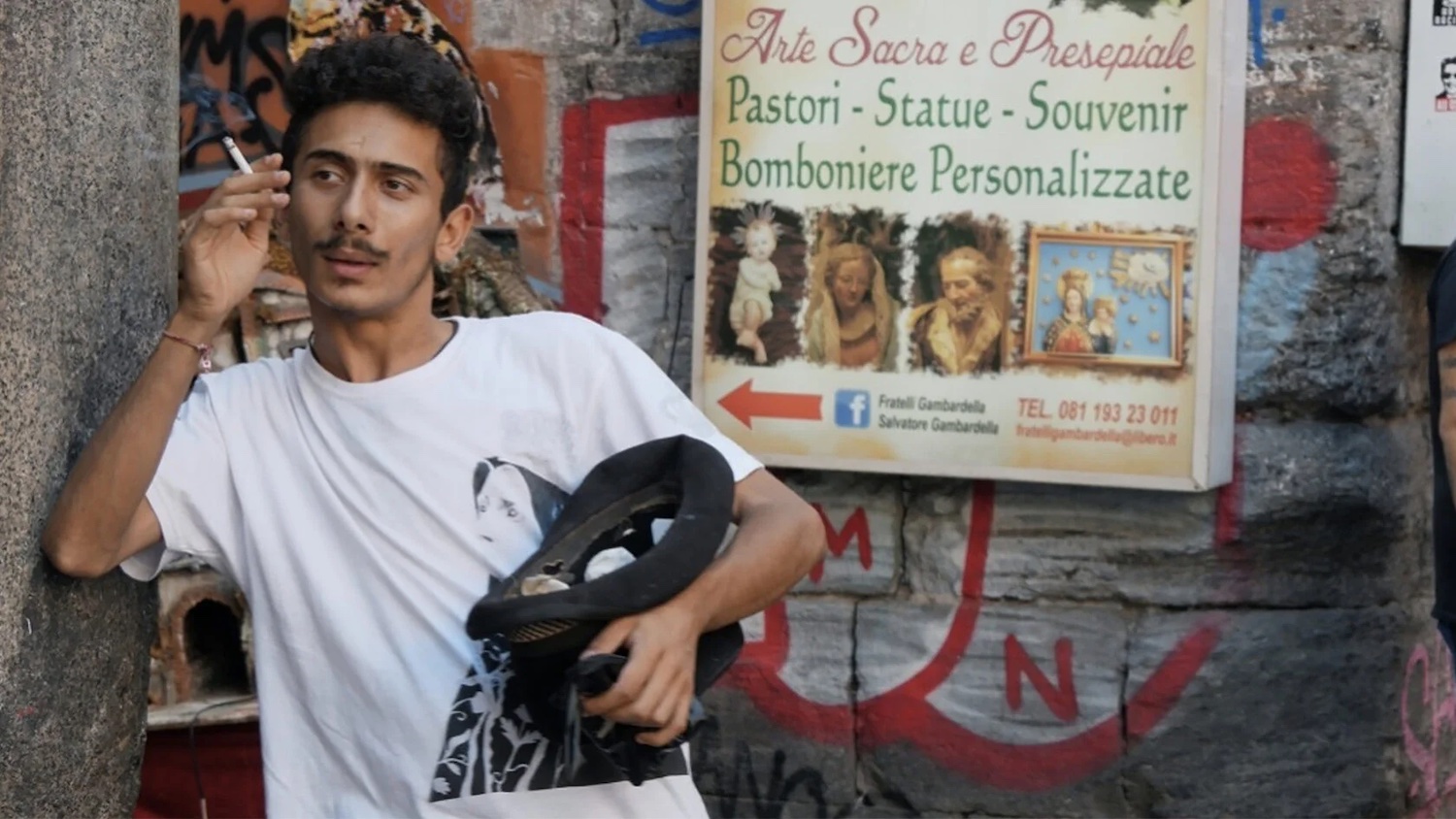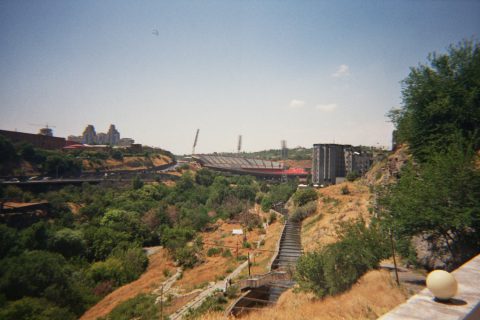When I stopped looking for Ararat, I accidentally found it. On a long walk to the Sergei Parajanov Museum to the west of the city, the buildings finally cleared and I caught a glimpse of the mountain, still shrouded in mist, with just the outline of its twin peaks and a snowy top visible. I took a picture, but all it shows is a thin outline. A faint representation of its potent majesty.
Inside the museum, I was treated to a bounty of riches. The museum is one of the European Film Academies’ Treasures of Cinema, alongside the Odessa Steps, the Notting Hill Book Store, Institut Lumière and Studio Babelsberg. A relatively small place with a mere two floors, it’s a cosy and welcoming trip into one of cinema’s most visionary minds.
While perhaps his famous films could be described as solemn and austere, deeply steeped in the lore of Ukrainian, Georgian and Armenian culture, his artworks feel like pop art, including various mock-ups of the Mona Lisa, self-portraits in different styles and a brilliant vision of America according to Lenin. His collagist techniques, abundance of imagination and sheer visual panache are a wonder to behold. If he never even made a single film, his status as an artist on what would be his 100th birthday is unassailable.

Perhaps it’s mentioned in the audio tour, available in Russian, English and Armenian, but I saw no mention of his bisexuality, one of the key reasons he was imprisoned in 1948 and 1973. It’s strange as for many LGBTQI+ Georgians and Armenians, Parajanov is a queer icon. (It’s worth noting here that significant discrimination still exists across the Caucasus, excellently displayed in works such as Elene Naveriani’s Wet Sand [2021] or Levan Akin’s And Then We Danced [2019])
But I did see his prison work, including gorgeously engraved coins made on aluminium foil caps. The ability to keep creating art, even in the worst possible conditions, is remarkable.
—

How Lady Madonna Makes Ends Meet
For art, and perhaps more specifically, iconography, the type Parajanov excelled at, can redeem us. My trip to the museum nicely dovetailed with the Neapolitan documentary The Gospel According to Ciretta (Caroline von der Tann, 2024), playing in the International Competition, a compelling work about the intersection of religion, art and personal salvation.
The eponymous Ciretta is a singer, performer and artist. He’s also the purest product of Neapolitan life that you might ever see, singing to people on the streets while selling lighters for money. With a fantastic vocal range and a wide repertoire of songs, he’s a pure delight to watch.
But his upbeat exterior belies a difficult upbringing. When he asked his prostitute mother who his father was, he was told that he was the product of 20,000 lire. He later followed his mother into the business. He refreshingly refuses to judge himself but is open about the difficulties of that work as well as the all-consuming redemption he found through Christ and Lady Madonna.
His unwavering faith seems to illuminate him from within, powering him on his quest to lead a procession of dead Jesus and Madonna statues through the narrow streets of the city. With great care and detail, von Der Tann shows us the immense labour and love that goes into creating these icons, with Ciretta showing remarkably openness in displaying his adoration of all things holy.
But this is far from a religious film, more of a very specific character portrait. Ciretta is a world-famous talker. His contemporaries, including those who give him a home, often contradict his words and views of religion, even going so far as to call him a bullshit artist.
And for those who don’t go in for all the religious iconography, the film also makes salient points about keeping the quirkiness and authenticity of local culture — whether that is music, religious ceremonies, street artists — in the face of faceless capitalism. Napoli is under threat, with over 10,000 holiday homes in the historic centre alone, pushing artists, independent businesses and working-class people out of their city. Gentrification means more and more pizzerias and fewer spaces for expression, a city for tourists while closed to the locals.
Ciretta might be so compelling because he feels like a rarity in an increasingly homogenous world, where every city one visits (including Yerevan) has yuppie burger restaurants, craft beer bars and co-working cafes. Set during the pandemic, what felt like a slow and steady process is accelerating, making portraits such as von der Tann’s so important in showing us what can so quickly be lost.

Collective Catharsis
It’s a different story in the Armenian Shorts programme, which casts art less as a form of redemption and more as a space for processing trauma. Heavy on recent events in Karabakh, my last experience at the festival was easily the most emotionally resonant.
The five Apricot Stone competition films were prefaced by a restoration of Genadi Meikonyan’s classic short Mulberry Tree (1979), based on the short story by Zorayr Khalapyan. It reminded me of Nikolai Gogol’s The Tale of How Ivan Ivanovich Quarreled with Ivan Nikiforovich (1835), set between people who have known each other for a very long time and whose friendship is never too far from spilling over into violence.
It concerns a shared mulberry tree situated between two family homes, with both patriarchs, Samson (Razmik Aroyan) and Gaspar (Leonard Sarkisov) arguing over the legitimacy. With a light comic touch, Meikonyan sketches the chaos of familial life, from the boys fighting the girls over dominance to a wee lad who appears to give birth to eggs and chickens. Particularly touching is the high irony of the ending, which just about manages to give everyone what they want.
Given that the Apricot Stone competition is named after Meikonyan himself, this restoration had a special resonance for the shorts programme, even if its classic sad comic Soviet style was at complete odds with the rest of the selection.
But The Egg (Vahan Grigoryan, 2024) eases into more serious topics to come, with a tragic-comedy that feels like Joker (Todd Phillips, 2019) by way of Dostoyevsky. A children’s entertainer, decked in a ridiculous chicken costume, dreams of better things, listening to motivational speeches as he performs, creating an odd dichotomy between who he wants to be and the sad reality of his everyday life. The egg metaphors quickly proliferate, culminating in an odd yet fitting nightmare.
Headless Horsemen (Ovsanna Gevorgyan, 2023) is easily the most aesthetically interesting of the shorts, with birds-eye-view takes, behind-the-shoulder shots and an almost complete lack of faces. A disturbing investigation into one woman’s unhealthy obsession with the events in Nogorno-Karabakh, including watching videos of torture to find missing soldiers, it uses its gloomy, yet precise frames to boil things down to their bare essentials. By avoiding the usual facial reaction shot, and focussing on arms, shoulders, the back of the neck, Gevorgyan somehow heightens the emotion at the heart of each scene. Tense, unnerving and disturbing, it captures a nation brought to the brink by the tumult and confusion of war.
Burden (Gevorg Nersesyan, 2024) has a similarly gloomy mood, but it’s shot through with layers of black humour and ironic-minded visuals. A partially deaf man is on his way to celebrate the birth of his daughter, before he is confronted with his brother — hiding in the back of his Volvo. Chased for unknown reasons, Burden explores the complexity of fraternal bonds with a grim sense of fatalism and an eye for striking compositions.
No Light / No Darkness (Margos Margossian, 2024) is the only American co-production among these Armenian shorts, and you can almost immediately feel the difference. There’s a gloss to the images and the editing that immediately feels more commercial, even if the story — concerning spy games around the Metsamor nuclear power plant, the only one in the South Caucasus — is needlessly complex. Using genre to explore Armenia’s desire for independence from the Soviet Union, before refracting that back to the energy crisis that recently faced Armenians in Karabakh, the back-and-forth editing and cheesy dialogue failed to keep me invested.
“What did you take with you?” asks director Anna Mkrtumyan of her grandmother in Armat (2024, above), referring to their swift departure from Karabakh before the Azerbaijan takeover. As her grandmother talks, the camera lingers on trees, soil, the sky. Using a mixture of memoir and the scientific essay film to explore the deep connection between biology and belonging, Armat gathers enormous power from its excellent use and exploration of dendrological metaphors.
Armat is a deeply moving work that left me emotionally drained, especially after the films of my first day here and through conversations with Armenians in Yerevan. While the events in Karabakh are upsetting to watch again and again and again, it’s at least heartening to know that, unlike previous conflicts, getting information out and distributing Armenian stories is easier than ever. It’s up to the rest of the world to listen.
Redmond is the editor-in-chief of Journey Into Cinema.
